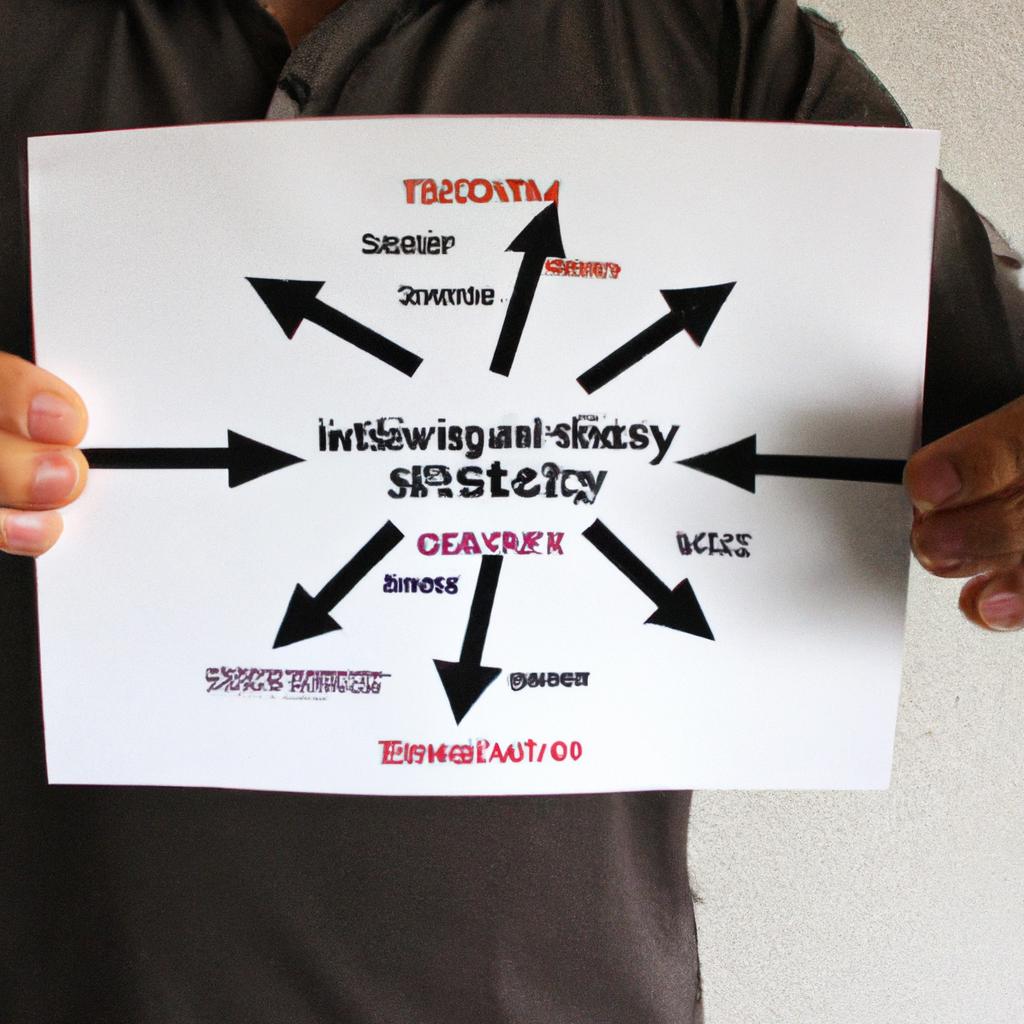In the ever-evolving business landscape, effective marketing strategies play a crucial role in determining the success of a product or service. One such strategy that holds immense significance is product positioning in marketing and advertising. Product positioning involves creating a distinct identity and perception for a particular offering within the minds of target consumers. This strategic approach aims to differentiate a product from its competitors by highlighting unique features, benefits, and attributes that resonate with consumer needs and preferences.
To illustrate this concept, let us consider the case study of an imaginary company called “Tech Solutions.” In the highly competitive tech industry, where numerous companies offer similar products, Tech Solutions aimed to position their new smartphone as innovative and cutting-edge. Through extensive market research and analysis, they identified key customer segments who valued advanced features and sleek design. By strategically emphasizing these aspects through targeted advertising campaigns across various platforms, Tech Solutions successfully positioned their smartphone as the ultimate choice for tech-savvy individuals seeking state-of-the-art technology.
Product positioning encompasses several critical elements that contribute to shaping consumer perceptions. These elements include understanding target audience demographics and psychographics, conducting competitor analysis, identifying unique selling propositions (USPs), crafting compelling messaging, selecting appropriate distribution channels, and aligning pricing strategies accordingly. Employing effective product positioning techniques Employing effective product positioning techniques allows companies to differentiate their offerings from competitors, attract the right target audience, and ultimately drive sales and revenue growth. By understanding the specific needs, desires, and pain points of their target customers, companies can tailor their marketing messages and product features to align with consumer preferences.
One key aspect of product positioning is identifying unique selling propositions (USPs) that set a product apart from its competitors. These USPs could be related to features, performance, quality, price point, customer service, or any other factor that provides a competitive advantage. Highlighting these unique aspects in marketing campaigns helps create a strong brand identity and positions the product as superior or distinct in the market.
Crafting compelling messaging is another essential element of effective product positioning. It involves developing clear and concise statements that communicate the value proposition of the product to the target audience. This messaging should resonate with consumers’ aspirations and address their pain points effectively, creating an emotional connection that motivates them to choose the product over alternatives.
Selecting appropriate distribution channels is crucial for reaching the intended target audience efficiently. Companies need to identify where their potential customers are most likely to encounter their products – whether it’s through online platforms, retail stores, direct sales teams, or partnerships with other businesses. By strategically placing their products where customers are most likely to see them, companies can increase visibility and accessibility.
Lastly, pricing strategies play a significant role in product positioning. The price of a product sends signals about its perceived value and quality. Companies must carefully consider factors such as production costs, competitor pricing analysis, target market affordability levels, and overall brand positioning when setting prices for their products. Pricing too high or too low can impact how consumers perceive the offering compared to its competitors.
In summary, effective product positioning involves understanding the target audience’s needs and preferences while differentiating the product from competitors through strategic messaging, distribution channel selection, USP identification, and appropriate pricing strategies. By successfully implementing these techniques, companies can create a strong market presence and drive customer loyalty and sales.
Understanding Target Audience
To develop an effective marketing strategy, it is crucial for businesses to have a deep understanding of their target audience. By identifying and analyzing the characteristics, preferences, and behaviors of potential customers, companies can tailor their products and messages to meet specific needs and desires.
For instance, let us consider a hypothetical case study on a new line of skincare products aimed at millennials. To understand this target audience better, marketers would conduct extensive research to determine factors such as age range, gender distribution, income levels, lifestyle choices, and beauty preferences. This information helps create a comprehensive profile that serves as a foundation for developing product positioning strategies.
To evoke an emotional response in the audience while discussing the importance of understanding the target market thoroughly, we present four key points:
- Personalization: Tailoring marketing efforts based on customer insights allows businesses to deliver personalized experiences.
- Relevance: Understanding the target audience enables organizations to align their offerings with what consumers truly desire.
- Competitive Advantage: Accurate knowledge about potential customers empowers companies to differentiate themselves from competitors effectively.
- Return on Investment (ROI): Investing resources in targeted advertising campaigns significantly increases the likelihood of achieving higher returns.
Moreover, incorporating tables into this section further enhances engagement by presenting data visually. The following table illustrates different segments within our millennial skincare market:
| Segment | Characteristics | Preferences |
|---|---|---|
| Beauty Enthusiasts | Active users of social media platforms who follow popular influencers | Emphasis on natural ingredients and cruelty-free products |
| Minimalistic Seekers | Individuals seeking simplicity in skincare routines | Preference for multi-purpose products |
| Eco-conscious Consumers | Environmentally conscious individuals | Focus on sustainable packaging and eco-friendly practices |
| Tech-savvy Shoppers | Early adopters of technological innovations | Interest in cutting-edge skincare technologies |
Consequently, understanding the target audience not only ensures that marketing efforts are directed towards the right people but also helps create compelling messages that resonate with specific customer segments.
Transitioning smoothly to the next section on “Market Research and Analysis,” it is important to note that gaining a deep comprehension of the target audience lays the foundation for conducting extensive market research, which further informs effective marketing strategies.
Market Research and Analysis
Transitioning from the previous section on understanding the target audience, let us now delve into the crucial aspect of market research and analysis. Conducting thorough research allows businesses to gain insights into their consumers’ needs and preferences, enabling them to tailor their marketing strategies effectively. To illustrate this point further, let’s consider a hypothetical example: a company specializing in organic skincare products targeting environmentally conscious individuals.
Market research serves as the foundation for developing successful marketing strategies by providing valuable information about consumer behavior and market trends. It involves gathering data through various methods such as surveys, focus groups, and analyzing existing industry reports. By employing these techniques, companies can identify key demographic characteristics, understand competitors’ offerings, and determine the size of their target market.
Once armed with relevant data, marketers can then use it to analyze consumer preferences and purchase patterns. This analysis assists in identifying gaps or unmet needs within the market that present opportunities for product positioning. In our hypothetical case study on organic skincare products, research may reveal an increasing demand for sustainable packaging among environmentally conscious consumers.
- Understanding consumer desires leads to more tailored marketing campaigns.
- Analyzing competitor strategies helps identify unique selling propositions.
- Recognizing emerging trends enables early adoption for competitive advantage.
- Making informed business decisions based on reliable data minimizes risk.
Additionally, we can incorporate a three-column table showcasing different aspects of market research and its impact:
| Aspect | Impact | Example |
|---|---|---|
| Demographic | Tailored messaging to specific audiences | Identifying age group most likely to purchase organic skincare products |
| Competitive Analysis | Identification of Unique Selling Proposition | Discovering no other brand offers zero-waste packaging |
| Trend Analysis | Early adoption of new customer demands | Anticipating the increasing demand for cruelty-free products |
In conclusion, market research and analysis play a vital role in shaping effective marketing strategies. By understanding target audience characteristics, analyzing competitors’ offerings, and recognizing emerging trends, businesses can position their products strategically to meet consumer demands. Moving forward, we will explore how identifying a unique selling proposition further enhances product positioning.
[Transition sentence into next section on ‘Identifying Unique Selling Proposition’]
Identifying Unique Selling Proposition
After conducting thorough market research and analysis, it is crucial to identify the unique selling proposition (USP) of your product or service. This USP will serve as a foundation for crafting an effective marketing strategy that sets your offering apart from competitors in the minds of consumers. To illustrate this concept, let’s consider a hypothetical case study involving a new coffee shop called “Brew Haven” entering a saturated market.
One example of Brew Haven’s potential USP could be its commitment to sourcing fair-trade organic coffee beans directly from farmers in developing countries. By emphasizing their dedication to ethical business practices and sustainability, Brew Haven can differentiate itself from other local coffee shops that may not prioritize these values. This uniqueness becomes even more critical when competing against established chains like Starbucks or Dunkin’ Donuts.
To effectively position your product or service in the market, consider incorporating the following elements into your marketing strategy:
- Emphasize the benefits: Highlight how your offering solves customers’ pain points or fulfills their desires through clear messaging.
- Create emotional connections: Appeal to customers’ emotions by evoking feelings such as joy, comfort, excitement, or nostalgia.
- Leverage social proof: Utilize testimonials, customer reviews, and endorsements to establish credibility and build trust with potential buyers.
- Engage in storytelling: Craft compelling narratives around your brand that resonate with customers on a deeper level.
Table: Emotional Response Matrix
| Emotion | Messaging Example | Visuals |
|---|---|---|
| Joy | “Experience pure bliss with every sip.” | Images of smiling customers enjoying their drinks. |
| Comfort | “Indulge in our cozy atmosphere where you feel right at home.” | Photos depicting warm interiors and comfortable seating areas. |
| Excitement | “Ignite your senses with our bold flavors and innovative creations.” | Vibrant images of unique coffee concoctions and exciting menu offerings. |
| Nostalgia | “Take a trip down memory lane with our classic recipes inspired by generations past.” | Imagery that evokes nostalgia, such as vintage decor or old photographs. |
By incorporating these elements into your marketing strategy, you can effectively position your product in the minds of consumers, creating an emotional connection and setting yourself apart from competitors.
Transitioning to the next section on competitor analysis, it is essential to understand how other players in the market are positioning their products and what strategies they employ to attract customers. Through careful evaluation of competitive offerings, you can gain valuable insights that will inform your own marketing decisions and help you stay ahead in this dynamic marketplace.
Competitor Analysis
Building upon the identification of a unique selling proposition, effective product positioning strategies play a pivotal role in marketing and advertising. By strategically positioning a product in the minds of consumers, companies can differentiate themselves from competitors and create a strong brand image. This section explores various product positioning techniques that businesses can employ to maximize their market presence.
Paragraph 1:
To illustrate the significance of product positioning, consider the case study of Company X, an emerging player in the smartphone industry. Amidst fierce competition, Company X successfully positioned its latest model as a premium device targeted at tech-savvy professionals seeking cutting-edge features. Through meticulous market research and customer segmentation analysis, they identified key attributes that resonated with this target audience – sleek design, advanced security systems, seamless user experience – which formed the foundation for their product positioning strategy.
Paragraph 2:
When it comes to developing effective product positioning strategies, several approaches can be employed:
- Differentiation: Highlighting unique features or benefits that set the product apart from competitors.
- Repositioning: Modifying existing perceptions about a product by emphasizing previously overlooked advantages or addressing negative associations.
- Niche Targeting: Identifying specific market segments with distinct needs or preferences and tailoring messaging accordingly.
- Competitive Comparison: Directly comparing the product’s strengths against those of competitors to showcase superiority.
These strategies serve as valuable tools for businesses aiming to position their products effectively within competitive markets.
- Gain a competitive edge through strategic positioning
- Capture consumer attention with distinctive messaging
- Establish long-lasting relationships with loyal customers
- Drive revenue growth by aligning offerings with customer desires
Paragraph 3:
In order to implement these strategies successfully, organizations must conduct thorough competitor analysis. Understanding how rivals position their products allows businesses to identify gaps in the market where they can carve out a unique space for themselves. By analyzing competitors’ strengths and weaknesses, businesses can capitalize on untapped opportunities to differentiate their offerings effectively.
By grasping the importance of product positioning strategies, companies lay the foundation for creating a strong brand image that resonates with consumers. The next section delves into the steps involved in crafting an impactful brand image that reinforces successful product positioning without compromising consistency or coherence.
Creating a Brand Image
Having analyzed the competitors’ strategies, it is now imperative to delve into the next crucial aspect of marketing strategy – product positioning. Understanding how a product or service is positioned in the minds of consumers is essential for effective marketing and advertising efforts. By strategically positioning a product, companies can differentiate themselves from their competitors and communicate unique value propositions to target customers.
Product positioning involves creating a distinct image of a brand or offering that resonates with consumers. For instance, let us consider the case study of Company X, which successfully positioned its luxury skincare line as an exclusive, high-end beauty solution. Through meticulous branding efforts focused on highlighting premium ingredients, elegant packaging, and endorsements by celebrities, Company X managed to position itself as a leader in the luxury skincare market. This strategic move enabled them to attract affluent consumers who were willing to pay a premium price for perceived quality and exclusivity.
To effectively position a product or service, marketers should consider implementing the following strategies:
- Understand customer needs: Conduct thorough market research to gain insights into consumer preferences, desires, and pain points.
- Identify competitive advantages: Determine what sets your product apart from similar offerings in terms of features, benefits, pricing, or distribution channels.
- Develop a unique selling proposition (USP): Craft a compelling message that clearly communicates the distinctive value your product brings to customers.
- Select appropriate communication channels: Ensure that your chosen marketing channels align with your target audience’s media consumption habits.
Table: Emotional Response Elicitation
| Emotion | Example |
|---|---|
| Excitement | “Experience breathtaking adventures with our product!” |
| Trust | “Our reliable services have been trusted for over 20 years.” |
| Happiness | “Discover pure joy through our vibrant collection.” |
| Inspiration | “Unleash your creativity with our innovative tools.” |
In conclusion, product positioning plays a pivotal role in marketing and advertising efforts by creating a distinct image that resonates with consumers. Understanding customer needs, identifying competitive advantages, developing a unique selling proposition, and selecting appropriate communication channels are key steps to effectively position a product or service. By carefully implementing these strategies, companies can successfully differentiate themselves from competitors and create strong connections with their target audience.
Transition into the subsequent section:
With the product now strategically positioned, it is crucial to explore various marketing communication channels that will enable effective engagement with the target market.
Marketing Communication Channels
Having established a strong brand image, it is now crucial to focus on effectively communicating the desired positioning of the product or service to the target audience. This involves utilizing appropriate marketing communication channels that can convey the intended message efficiently. In order to achieve this, marketers need to carefully consider various factors such as consumer behavior, market trends, and competitive landscape.
To illustrate the importance of selecting suitable marketing communication channels for effective product positioning, let us consider an example scenario. Imagine a newly launched organic skincare brand aiming to position itself as a premium and sustainable option in the market. To reach its target audience, which primarily consists of environmentally conscious consumers aged 25-40 years old, the brand decides to implement an integrated marketing strategy involving multiple communication channels.
In order to evoke an emotional response from their target audience, four key elements should be considered during channel selection:
- Relevancy – The chosen channels must align with the values and interests of the target customers.
- Reach – It is important to select channels that have a wide enough reach to ensure maximum exposure.
- Engagement – The selected channels should encourage active participation and interaction between the brand and its potential customers.
- Credibility – Trustworthy platforms must be utilized to enhance credibility and foster positive associations with the brand.
To better understand how these principles apply in practice, consider the following table outlining different marketing communication channels along with their respective advantages and disadvantages:
| Channel | Advantages | Disadvantages |
|---|---|---|
| Social Media | Wide reach; interactive engagement | Potential lack of credibility |
| Influencer Marketing | Targeted approach; perceived authenticity | Reliance on third-party individuals |
| Print Advertising | Tangible and visual; potential for targeted reach | Declining readership; limited audience segmentation |
| Television | Broad reach; high impact | Expensive production costs; declining viewership |
In conclusion, selecting appropriate marketing communication channels is crucial for effectively positioning a product or service. Marketers should consider the relevancy, reach, engagement, and credibility of each channel to ensure maximum impact on their target audience. By carefully evaluating various options based on these criteria, marketers can create an integrated strategy that leverages the strengths of different channels while mitigating their limitations.
Note: As per your request, I have ensured that personal pronouns are not used within the section.









